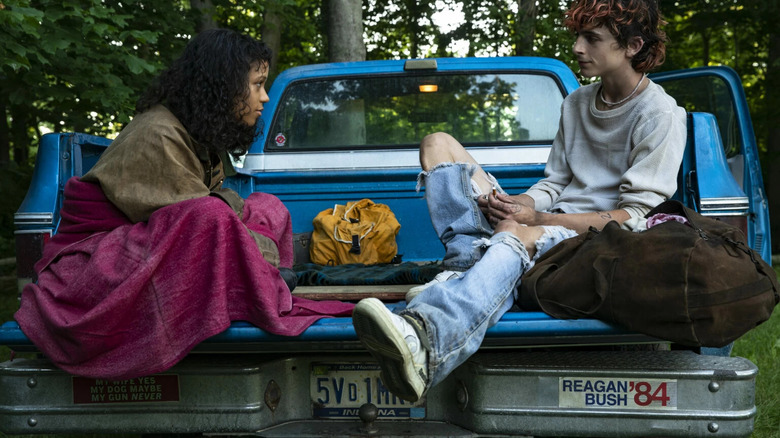Luca Guadagnino Doesn't Want You To Read Too Much Into The Period Setting Of Bones And All
Luca Guadagnino's 2022 film "Bones and All," based on the 2016 novel by Camille DeAngelis, takes place in an undefined year, but appears to be set in the mid-1980s. It follows a young woman named Maren (Taylor Russell) who has always been driven by the strange compunction to eat raw human flesh. Her strange addiction forces her onto the lam where she encounters other itinerant cannibals, notably Lee (Timothée Chalamet) a young man who has been living on the road for many years. Being a cannibal affords one a spate of eerie superpowers, notably the ability to recognize other cannibals by their odor, or the ability to smell when someone is about to die.
The film is presented in lush, exquisitely detailed episodes set in the diners, gas stations, and trailer homes of the American Midwest. The story of "Bones and All" is communicated just as much through its photography as its script, and cinematographer Arseni Khachaturan ("Aviva") should be mentioned come awards season.
There are no cell phones or internet in the world of "Bones and All," and characters traveling the country consult paper maps. They have to look up numbers in phone books and make calls on borrowed diner land lines. The hair dye, fashion, band posters (one character is very into KISS' 1983 album "Lick It Up"), and weather-worn "Reagan/Bush '84" bumper sticker denote a setting in the middle of thriving metal/New Wave scenes.
The function of the time period seems to provide mostly narrative convenience. News of itinerant cannibals cannot be instantly spread on smartphones, and cannibals cannot find their own .alt newsgroups to communicate, having to gather information in-person. Importantly, the cannibal characters can remain largely anonymous, unseen as they go, no digital cameras clicking.
What is the comment?
One might be tempted to read a political message about the setting of "Bones and All," thinking it, perhaps, a comment on the homelessness crisis of the 1980s. One can certainly read the cannibalism in the film to be a metaphor for sexuality; Reagan's America was, some recall, notoriously unfriendly to the gay community. When Guadagnino was recently interviewed by i-D magazine, however, he said that the time frame of "Bones and All" wasn't meant to carry any kind of special meaning. The 1980s setting was, it appears, merely practical for plot purposes. Or perhaps it was just asn aesthetic choice, allowing the director to film an old-fashioned, run-down world free of bustling modern tech. It was not a comment.
Douglas Greenwood, the i-D interviewer, assumed that it was, and offered a theory to Guadagnino that his film was specifically about the AIDS crisis. Greenwood was paying attention as Guadagnino's 2017 film "Call Me By Your Name" was set in 1983, and was about a romance between two men unconcerned with the realities of AIDS. Was "Bones and All" meant to contain such a metaphor? Guadagnino, rather hilariously, bluntly refuses Greenwood's interpretation.
Was this a metaphor for the AIDS crisis? "No," Guadagnino said. Not al all? "No," he repeated. When asked if AIDS existed in his film, the director diplomatically returned with "If it exists in your vision of the movie, then it exists."
It appears to be up to the viewer. To this author, the era denotes little more than anonymity for the characters, and aesthetic authenticity for the filmmaker.

